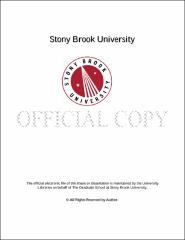| dc.identifier.uri | http://hdl.handle.net/11401/76857 | |
| dc.description.sponsorship | This work is sponsored by the Stony Brook University Graduate School in compliance with the requirements for completion of degree. | en_US |
| dc.format | Monograph | |
| dc.format.medium | Electronic Resource | en_US |
| dc.language.iso | en_US | |
| dc.publisher | The Graduate School, Stony Brook University: Stony Brook, NY. | |
| dc.type | Dissertation | |
| dcterms.abstract | Distributed energy resources (DER) are emerging rapidly. New engineering technologies, materials, and designs improve the performance and extend the range of locations for DER. In contrast, constructing new or modernizing existing high voltage transmission lines for centralized generation are expensive and challenging. In addition, customer demand for reliability has increased and concerns about climate change have created a pull for swift renewable energy penetration. In this context, DER policy makers, developers, and users are interested in determining which energy technologies to use to accommodate different end-use energy demands. We present a two-stage multi-objective strategic technology-policy framework for determining the optimal energy technology allocation for DER. The framework simultaneously considers economic, technical, and environmental objectives. The first stage utilizes a Data Envelopment Analysis model for each end-use to evaluate the performance of each energy technology based on the three objectives. The second stage incorporates factor efficiencies determined in the first stage, capacity limitations, dispatchability, and renewable penetration for each technology, and demand for each end-use into a bottleneck multi-criteria decision model which provides the Pareto-optimal energy resource allocation. We conduct several case studies to understand the roles of various distributed energy technologies in different scenarios. We construct some policy implications based on the model results of set of case studies. | |
| dcterms.available | 2017-09-20T16:51:20Z | |
| dcterms.contributor | Lewis, Herbert F. | en_US |
| dcterms.contributor | Ferguson, David | en_US |
| dcterms.contributor | Sexton, Thomas R. | en_US |
| dcterms.contributor | Salins, Peter | en_US |
| dcterms.contributor | Silkman, Richard. | en_US |
| dcterms.creator | Mallikarjun, Sreekanth | |
| dcterms.dateAccepted | 2017-09-20T16:51:20Z | |
| dcterms.dateSubmitted | 2017-09-20T16:51:20Z | |
| dcterms.description | Department of Technology, Policy, and Innovation. | en_US |
| dcterms.extent | 123 pg. | en_US |
| dcterms.format | Application/PDF | en_US |
| dcterms.format | Monograph | |
| dcterms.identifier | http://hdl.handle.net/11401/76857 | |
| dcterms.issued | 2014-12-01 | |
| dcterms.language | en_US | |
| dcterms.provenance | Made available in DSpace on 2017-09-20T16:51:20Z (GMT). No. of bitstreams: 1
Mallikarjun_grad.sunysb_0771E_12107.pdf: 2554101 bytes, checksum: d72b8cbef57257ce25e80880c0ae96bc (MD5)
Previous issue date: 1 | en |
| dcterms.publisher | The Graduate School, Stony Brook University: Stony Brook, NY. | |
| dcterms.subject | Energy | |
| dcterms.subject | Data Envelopment Analysis, Distributed Energy Resources, Distributed Generation, Energy Policy, Multi-Objective Optimization, Optimal Allocation | |
| dcterms.title | Energy Technology Allocation for Distributed Energy Resources: A Technology-Policy Framework | |
| dcterms.type | Dissertation | |

